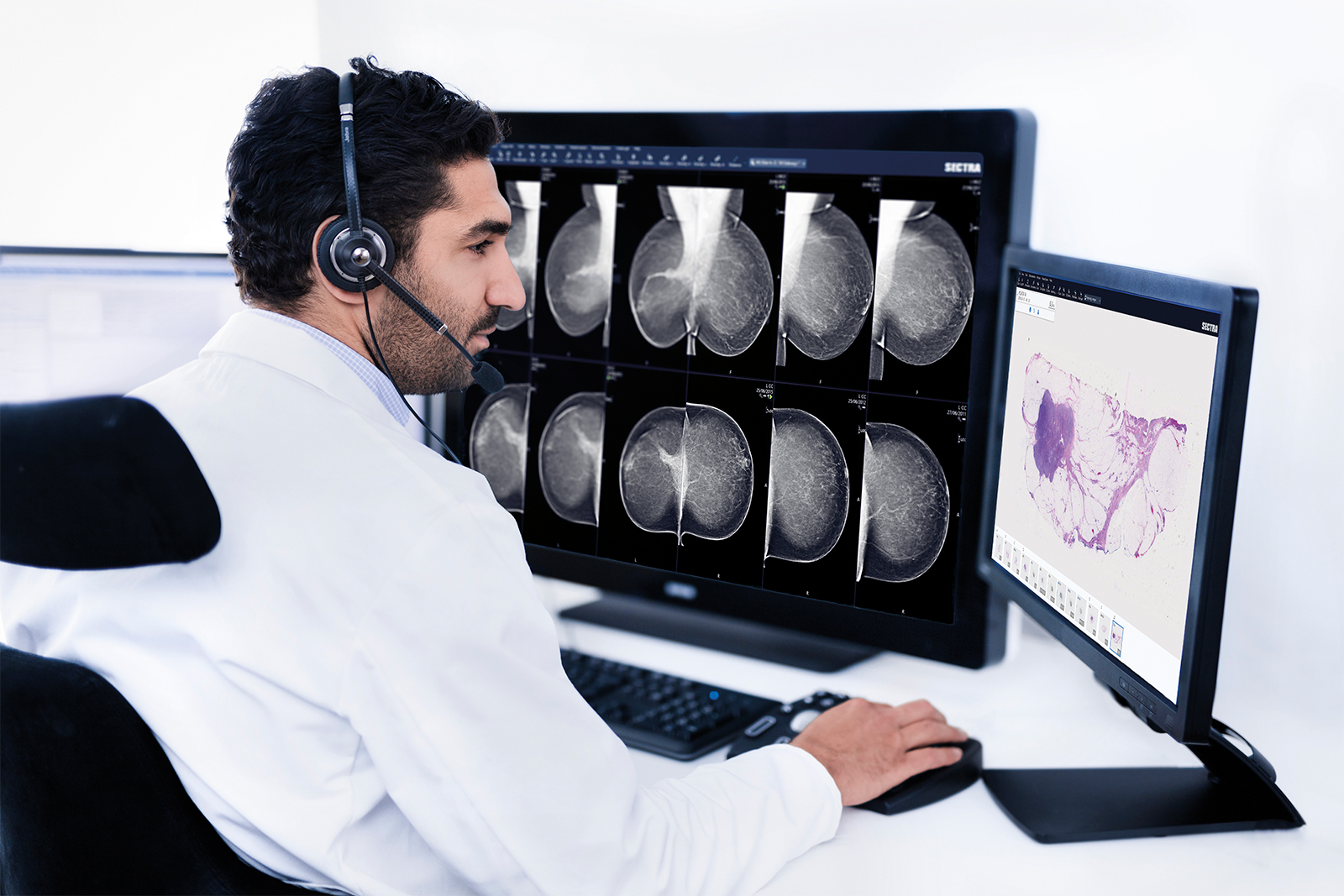AI is now essential for automation in radiology and pathology, but it provides a means to support the human, not replace.
Will I be replaced by a robot? Mainstream media reporting on artificial intelligence has led many people to ask this question. AI has gone from being the subject of science fiction and theory, to creeping into the reality of everyday life – either augmenting or starting to replace the way people carry out mundane tasks in their homes, in our supermarkets, on our roads and even where we work.
With a growth of AI in healthcare too, people who work in diagnostic disciplines such as radiology and pathology might just as easily ask questions about the security and shape of their future role.
Pragmatically, there is a very important role for AI in diagnosing illness – but for the foreseeable future, AI cannot make the human redundant. Instead it is a means to eliminate repetitiveness through automation and in turn to make sure professionals have the capacity to do those tasks for which they are indispensable.
Descending from a peak of inflated expectations
When people think about what AI might do to help identify illnesses, there has been a tendency to leap to extreme use cases.
People might think of man vs machine scenarios, where computers will take over the prediction and identification of cancers and other illnesses altogether. A peak of inflated expectations has emerged, as Gartner might describe it in its Hype Cycle for Emerging Technologies.
When we start to come down from that peak to look at the low hanging fruit, it becomes clear that AI and the associated possibilities for automation, can make a more mundane, but nevertheless more immediate and positive difference to the productivity of our radiologists and pathologists.
The real value of AI in diagnosing illnesses might not create attention grabbing headlines, but it means improving the ability of the NHS to orchestrate its workflow and to enable a more automatic triaging of imaging, so that serious cases can be prioritised.
Overcoming resource dilemma
The idea of 100% of imaging being analysed and reported by machines, rather than a person, is many, many years away from reality, and may possibly never happen. But that doesn’t mean there aren’t massive gains to be made today.
With an urgent need to respond to growing volumes of work, rising masses of imaging, and the fact that there are simply too few professionals to cope with escalating demand, AI offers opportunities to avoid costly delays in diagnoses that could significantly harm patient outcomes, even in the context of modern healthcare pressures.
AI applications and algorithms emerging now, mean that computing technologies are able to recognise abnormalities and flag those cases to relevant staff.
This automation supports radiologists and pathologists, not only enabling the most urgent studies to be reviewed first, but more than that, allowing specialist staff to be alerted to the more complex cases that require their attention, whilst others might be dealt with by less experienced teams.
Human in the loop
Diagnosis of a huge range of conditions are particularly well suited to AI assistance, in particular conditions which are more common, where potentially millions of images have been used to train algorithms through extensive machine learning.
Many other, more specialist cases, are not yet suited to AI techniques, where it remains of crucial importance that they are visualised from the beginning by a professional.
In either of these instances the radiologist or pathologist still performs a very necessary role, supported by technology that helps to ensure a greater level of consistency. These human in the loop interactions allow for the best in time efficiency and diagnostic accuracy.
Ki-67 protein cell counting is a strong example of AI in reality. This very time consuming and laborious task, has been automated in parts of the world including Linköping and Utrecht, by applying an algorithm that within seconds identifies up to 1,000 cells within a region of interest – the area that the pathologist needs to be concerned with.
The human is in the loop to fix any incorrect positives and negatives, but the algorithm in conjunction with the pathologist, reduces the time that would be spent manually counting cells, whilst ensuring the highest level of accuracy.
No single technology
AI is advancing at such a pace it is far beyond what any single technology provider could ever hope to cover. Medical imaging technology suppliers must provide an open interface to give very clever people the opportunity to apply their innovations.
Radiologists, and increasingly pathologists, are accustomed to working with a single harmonised user interface, where they have all the diagnostic information at their fingertips.
If it is to be used and accepted, AI must become harmoniously available to users in the systems already being used – such as their picture archiving and communication system, so that they can access that AI functionality for imaging they are working with. In November 2017 a vendor neutral ecosystem was launched to make this possible, enabling hospitals to choose which AI vendors to work with.
We are working with AI partners to enable algorithms to run in the background on a CT scan or any imaging, to highlight conditions that the radiologist might not otherwise be looking for.
AI acceptance
AI is now increasingly being accepted by the clinical community as being absolutely essential. Diagnostic departments too are embracing this trend, and just as 10 years ago radiology looked very different than it does today, 10 years into the future, I have no doubt that will be repeated for many ‘ologies’.
The drive for better diagnoses will be the prevailing factor. A radiologist or pathologist that uses AI will be better than one that doesn’t.

